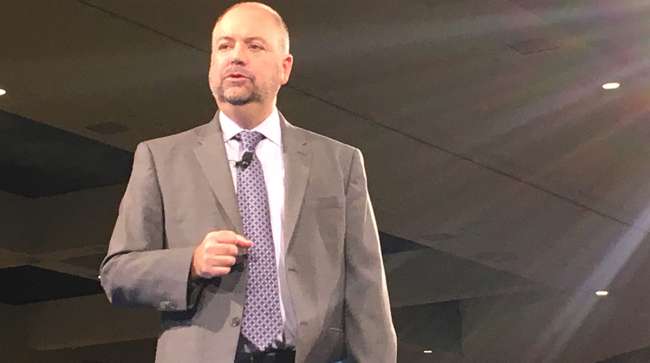Trucking Market Strongest Since Deregulation, ATA Economist Bob Costello Says

NASHVILLE, Tenn. — The freight market is as strong as it has been since deregulation in the 1980s, according to American Trucking Associations Chief Economist Bob Costello.
Speaking at the Natso Connect conference here, Costello said that anecdotal fleet reports suggest January 2018 was one of the best starts to a year in recent memory.

“We are very close to being at full employment in this economy. When the job market is tight, wages are going up. And when people’s wages go up, they generally spend it. Wages are expected to grow 3% this year. Spending on goods, excluding services, I think, is going to grow 4.3% this year,” he said.
The gross domestic product grew at a 2.6% annualized rate in the fourth quarter, compared with 1.8% one year ago. In 2017, the economy expanded 2.3%, a sharp jump from the 1.5% it grew in 2016, he said.
Truckload shipments grew nearly 3% last year, but in the fourth quarter volumes jumped 7% year-over-year. It was a remarkable turnaround from a slow first five months of 2017. By trailer type, dry-van loads rose 2%, flatbed increased 2.2% and temperature-controlled improved more than 5%.
The Tax Cuts and Jobs Act will drive more Americans to spend on durable and nondurable goods because the lower tax rates will increase paychecks, Costello said. For-hire fleets transport these items.
Housing starts last year were the strongest since 2007, according to the federal government, so the construction market is thriving even before new infrastructure spending under the Trump administration.
“Factory output, we went from very soft factory growth to last year it grew of about 1.5%. This year and next year I think it’ll be 3% to 3.5%. The three major buckets of freight are all doing well right now,” Costello said.
Despite the rosy outlook, Costello does not share the view of other economists that the U.S. economy will expand at an annualized rate of 3.5% or higher for a sustained period, estimating about 2.7% in 2018 and 2019. To achieve some of the lofty 4% to 5% estimates, he said there would need to be a population boom to produce and consume goods.
In spite of rising truckload volumes, average length of haul did not change year-over-year, although that is an improvement on the declines in 2015 and 2016. The data, however, reflects the new reality in which shippers use regional distribution networks to quickly deliver online orders, a demand consumers increasingly expect from their retailers, he said.
On North American trade, ATA reports that cross-border freight supports more than 46,000 trucking jobs, including nearly 31,000 U.S. truck drivers. The North American Free Trade Agreement generates $6.5 billion per year in revenue for the trucking industry.
Manufacturers, for example, partially assemble durable goods in the United States but transport the items on trucks or trains to Mexico to complete assembly. If this supply chain were to be disrupted, then these producers worry about rising production costs.
Costello believes with the Mexican presidential election coming in July and the U.S. midterms in November, ongoing discussions about renegotiating NAFTA would have to be completed before mid-April.
“The odds of getting a deal at this point, while not impossible, are very, very low,” he said. “This is one risk to the economy. If we were to pull out of NAFTA, you can wipe out all the good that has happened so far.”

